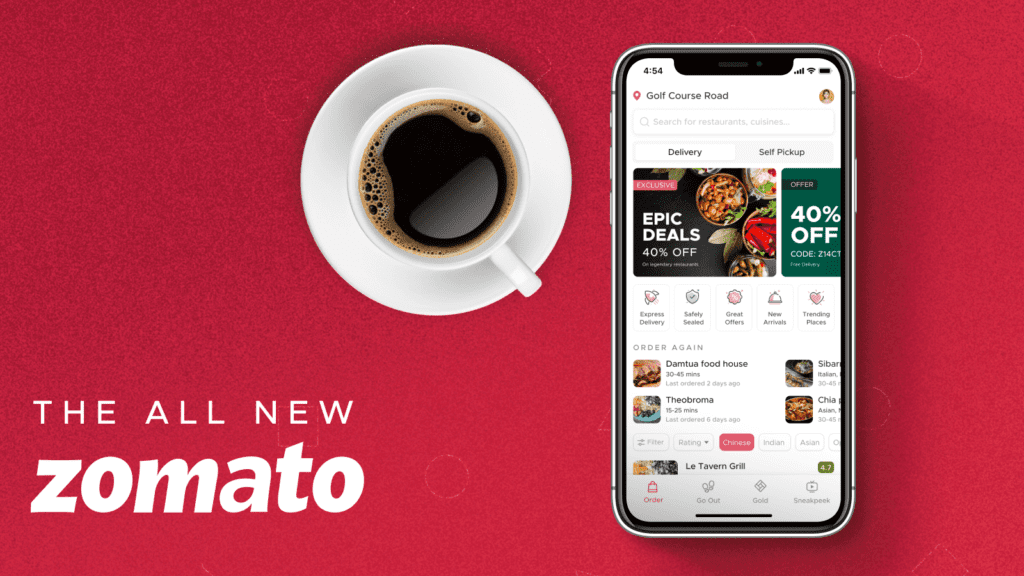What sets Zomato apart from the plethora of food delivery applications available today?
Marketing techniques which Zomato applies are a chimera of innovation and standard since their targeted aim is to satisfy customers’ hunger while establishing customer loyalty. From knowing what their consumers want before anyone else, to catering to their needs through a memorable and entertaining service that the audience can both use and enjoy, Zomato has transitioned from being just a utility company to an entertainment driven brand.
So let’s find out how Zomato has successfully transformed food consumption into a cultural statement.
4Ps Strategy of Zomato

Zomato’s success story is a fascinating blend of clever strategies, innovative solutions, and deep customer understanding. Let’s dive into how the 4Ps- Product, Price, Place, and Promotion – shape Zomato’s winning formula in the competitive food delivery and restaurant discovery space.
1. Product:
Zomato serves a delectable range of services tailored to meet diverse customer needs. From finding the perfect dining spot to delivering your favorite meals, here’s what’s on their plate:
- Restaurant Search and Discovery: Zomato lets users explore restaurants, cafes, and pubs by location, cuisine, and ratings, with detailed menus, reviews, and photos. It’s your ultimate food guide!
- Online Table Booking: Skip the queues with Zomato’s table reservation feature, often bundled with special deals and discounts.
- Food Ordering and Delivery: The backbone of Zomato’s platform, it connects users to countless eateries, bringing deliciousness to their doorsteps.
- Subscription Services: With Zomato Pro (previously Zomato Gold), diners enjoy exclusive perks like discounts, complimentary items, and more.
Innovative Additions:
- Hyperpure ensures restaurants get fresh, high-quality ingredients.
- Zomato Kitchen supports cloud kitchens, enabling restaurants to expand reach without dine-in spaces.
- Zomato Pay simplifies transactions for dine-in and delivery orders.
- Events and Experiences like food carnivals add spice to the customer experience.
2. Price:
Zomato’s pricing strategy ensures affordability while driving growth:
- Competitive Pricing: Staying in line with market trends to attract customers and stay ahead of competitors.
- Dynamic Delivery Pricing: Flexible charges based on distance, order size, and demand (like during peak hours).
- Subscription Models: Zomato Pro offers discounts and free delivery, creating loyal users while ensuring steady revenue.
- Freemium for Partners: Restaurants can list for free but pay for promotions and analytics, creating a win-win.
- Promotions and Offers: Regular discounts and festival-specific deals keep customers engaged.
- Tailored B2B Pricing: Through Hyperpure, restaurants get customized pricing for supplies, ensuring cost-effectiveness.
3. Place:
Zomato has established a robust presence worldwide, with a thoughtful approach to location:
- Wide Reach: Over 1,000 cities in India and expanding globally, focusing on urban hubs with high food delivery demands.
- Local Partnerships: Collaborating with diverse eateries, from local joints to big chains, ensures a rich listing.
- Tech-Driven Operations: AI optimizes delivery routes for faster service and happier customers.
- Strategic Market Entry: Zomato starts with metro cities before expanding to smaller towns, ensuring steady growth.
- Localized Services: They adapt to local tastes, preferences, and regulations, offering a personalized touch.
4. Promotion
Zomato’s promotional strategies are as dynamic as their service:
- Digital Marketing: From quirky memes to moment marketing, Zomato excels on platforms like Instagram and Twitter, keeping audiences entertained and engaged.
- Search Engine & Email Marketing: Targeting both new and existing users with personalized campaigns.
- Television & Print Ads: Memorable campaigns like “Doodh Mangoge Doodh Denge, Kheer Mangoge Kheer Denge” resonate with a broad audience.
- Promo Activities: Discounts, free delivery offers, and seasonal campaigns make Zomato irresistible.
- Website Optimization: Leveraging tools like Google Analytics, Zomato ensures a seamless customer experience, converting visitors into loyal users.
Paid marketing strategy
Now you must have noticed that certain brands like Zomato keep coming up at the right time, this can all be attributed to paid marketing. Unlike organic advertising, paid advertising is not something that is done once then left for a while. It’s about being active in the places where the audience is present to discover the brand’s activity. The real kicker? It increases visits on their website or app a notch higher and even refines their searches.
Search Ads:
Now, I think it’s necessary to discuss Search Ads first. Don’t we all sometimes Google something and find out that some of the links that appear to be a part of the search options are actually advertisements? That’s exactly how search advertising works. It is one of the categories of Internet ads that appear every time we search on the World Wide Web. For Zomato, this act is in fact part of their business model since it threatens traditional food delivery services. Not only does it increase their on-line presence but it also allows them to accrue vast amounts of information about which keywords are resonating with people like you and me who love food.
Display Ads:
On to Display Ads – no common ads here, these are like the internet’s billboards. They use them to give the eye a little beauty as you surf through the website, magazine or newspaper at your disposal. These ads can come in almost any format, from a gorgeous picture of your favorite meal or a catchy video to an audio clip. This they are not, however. These ads are then placed on multiple websites to ensure that the Zomato brand is fresh in your mind and you make that ever so enjoyable decision to order food in.
Segmentation-Targeting-Positioning (STP) of Zomato

Today, Zomato makes sure that it has got your back whether in the wee hours of the night or when you’re planning a formal date. Well, it’s no magic – it’s Segmentation, Targeting and Positioning (STP) done smart. It is high time we get a taste of tasty strategy that puts Zomato on the top of our food list.
Segmentation: Who’s Hungry? Zomato knows its crowd well. The core immature population of 18 to 35-year-olds is Zomato’s playpen, several students and young working population, and everyone who is too busy to cook yet does not want to eat junk food. And it’s not just about bringing your favorite dishes, it also makes the joy of food tangible with things like Zomaland, the food festival that becomes a platform for thrilling experiences. Whether it is Tacos or Sushi, Zomato has the best restaurants in town lined up just for its users.
Targeting: Anyone who has been using Zomato is aware that it is all about targeting the young and the restless. The main consumers are those of us who switch between wanting to try the newest chic restaurants or fast food joints but also craving the consistent and familiar food that our favorite restaurants serve. Not that it only for the On-the-go foodies but for those planned dinner dates where perfection is desired. Simply put, it’s about sharing food and drink with friends or even ordering something nice for when you’re going to spend the night alone watching Netflix.
Positioning: Not just a Food Delivery App: Zomato has grown not just to be an online food delivery application kind of service to a complete food solution app. This way it brands itself as the center of food based, it takes the hunger and delivers it to kitchens in different cities. With the use of ratings and reviews, Zomato is not only an ordering platform, but also a home to everyone whose judgment defines the restaurants of the world. Straight, introducing Zomato Gold was a masterstroke which made group gourmet affordable, or should we say, changed the dynamics of dining completely.
Meme marketing by Zomato
Zomato knows that humor sells. Their memes aren’t just funny – they’re relatable and shareable, blending food fails and snack wins with a side of hilarity. This isn’t just marketing; it’s meme-ing with a purpose.
Why Memes, Though?
Because memes stick. They’re the language of the web, perfect for quick shares and even quicker smiles. Each meme shared not only boosts Zomato’s visibility but also wraps the brand in a vibe of cool relatability.
The Delicious Impact?
Massive. Zomato’s meme strategy isn’t just for laughs; it drives organic traffic and, effectively, revenue. It’s word-of-mouth for the digital age.
So, next time you chuckle at a Zomato meme, remember- it’s part of a clever dish served hot by Zomato, designed to fill both your feet and your belly!
Push Notifications by Zomato
You ever wonder why Zomato has a way of reminding you that you are craving a hamburger or longing for pizza? This is far from a coincidence – it is a result of a highly targeted push notification system built to feed your desires.
Instead of just delivering meals, Zomato has a different philosophy. Desiring to offer the exciting, unique experience of an individual preference fitting the particular inclinations and frequency of an address. Whether you are binge-watching your favourite series on your couch or completely immersed in work to even consider where your next meal will come from, Zomato’s alerts come at the absolute right time.
Here’s how they do it: Therefore, Zomata constructs its notifications based on the combination of the best data-analysis and monitoring of the customer’s profile. They take into account your previous orders, your location proximity, and choice of dining to make sure every message is relevant. If your search query involves frequent use of hot terms, be ready to receive concepts linked with the spiciest places. If you are a dessert lover make sure to closely watch out for any sweet spot near you.
What really sets Zomato apart is their clever use of language and cultural touchpoints, making each notification feel like a note from a friend who knows your culinary quirks. They might reference a trendy TV show you’re watching or the latest meme, connecting over more than just food.
So, when your phone lights up with a suggestion from Zomato, it’s more than an alert—it’s an invitation to enjoy a meal that feels personally chef-picked just for you. Zomato doesn’t just feed you; they feed your lifestyle.
Email Marketing Strategy of Zomato
Zomato knows its audience loves a good laugh and timely content. By aligning their email campaigns with current events or popular culture, they keep their content fresh and relevant. Remember when Mirzapur Season 2 was all the rage? Zomato was right there, riding the hype train with a clever nod: “Munna Bhaiya invited you to a weekend.” It’s not just an invitation; it’s a pop culture party in your inbox!
Savory Subject Lines
The secret sauce of any email campaign is the subject line, and Zomato has this down to a science. With witty one-liners that are too good to miss, they manage to capture the essence of their message in a fun and engaging way. Think of it as the appetizer that sets the stage for the main course- enticing you to dig deeper and see what’s inside.
Enticing Call to Action
Zomato doesn’t just make you smile; they make you click. Each email ends with a compelling call to action that’s perfectly paired with their fun themes. From the “curryculum vitae of biryani” that urges you to “order now” instead of hire, every CTA is a clever play on words that ties back to their food-first philosophy. It’s like the perfect dessert ending to your meal; it leaves you satisfied yet wanting more.
Why It Works: Connecting Through Creativity
Zomato’s email marketing strategy is effective because it’s built on a foundation of creativity and connection. They don’t just send email, they send experiences that resonate with their audience’s tastes and interests. This approach not only strengthens brand loyalty but also boosts engagement, turning every email open into a potential order.
Marketing Campaign By Zomato
1. The Story of Raksha and Bandhan: Zomato’s 2023 Campaign
For Raksha Bandhan 2023, Zomato launched a heartwarming campaign that cleverly played on the love-hate relationship between siblings. The campaign was titled “The Story of Raksha and Bandhan,” and it featured humorous and relatable advertisements showcasing siblings in various bittersweet scenarios that anyone with a brother or sister could instantly connect with. The campaign’s core message highlighted the idea that siblings are indispensable to each other despite their frequent squabbles. This not only resonated widely with its audience but also cleverly tied into Zomato’s service by suggesting that food is another essential link that brings siblings together during both quarrels and celebrations.
2. Zomato vs. Zomato Campaign
Zomato’s innovative marketing strategy included a campaign that turned a common confusion—how to pronounce “Zomato”—into a playful debate between two cricket legends, Harbhajan Singh and Sreesanth. This choice of personalities was particularly clever given their notorious history on the cricket field, where they had a well-publicized on-pitch argument. By using this rivalry, Zomato created a series of engaging and humorous ads where the two debated the pronunciation of “Zomato,” capturing the audience’s attention and driving the conversation around the brand. The campaign not only highlighted the brand’s name but also leveraged celebrity endorsements in a unique and memorable way.
3. Humans of Zomato Featuring Delivery Agents
Zomato further humanized its brand through the “Humans of Zomato” series, which spotlighted their delivery agents. This campaign involved interviews conducted by Zomato anchors who engaged with delivery agents in a light-hearted and fun manner. These stories went beyond the usual transactional nature of delivery and showcased the personal lives, challenges, and dreams of the agents. By doing so, Zomato created an emotional connection with its audience, reinforcing the company’s compassionate image and its commitment to the welfare of its employees. This series not only boosted customer loyalty but also painted a positive image of the brand as caring and responsible.
4. Breaking Breads with Founders & CEOs of Food Brands
Inspired by the iconic series “Breaking Bad,” Zomato launched “Breaking Breads,” a YouTube podcast series where the founders of various food brands were invited to share their stories. This series included notable guests from popular food chains like Farzi Cafe and Biryani by Kilo. The format allowed for deep dives into the journeys of these food entrepreneurs, discussing challenges, successes, and insights into the food industry. “Breaking Breads” provided valuable content for food enthusiasts and aspiring entrepreneurs, showcasing Zomato’s role as a key player in the food industry while also providing a platform for other brands to shine.





